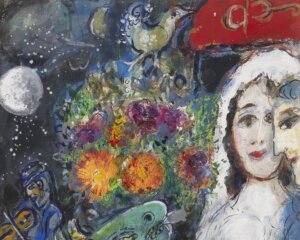How Marc Chagall mastered color and made Jewish painting kosher
A New Orleans exhibit examines Chagall’s popularity and influence

Courtesy of M.S. Rau Gallery
“Dreaming in Color: Chagall and His Circle,” an exhibit at M.S. Rau, may well be unprecedented, says Bill Rau, the third generation owner of the New Orleans-based gallery that sells fine arts, antiques and jewels.
Many of the 48 paintings on display, including more than 30 works by the Belorussian-born French Jewish artist, Marc Chagall (1887-1985) are “fresh to the market,” Rau told me over the phone. “Most have been in private hands or lying unframed in drawers. It’s exceptional to see this many Chagall paintings in any one exhibit.”
Even if you can’t make it to the French Quarter, you can still view the great works in a virtual online presentation that also features paintings of such iconic artists as Henri Matisse, Jean Dufy, Kees van Dongen and Reuven Rubin. To varying degrees Chagall influenced them and they influenced him, says Rau.
That said, he stresses that Chagall was a “groundbreaker” who “was not part of any movement.”
“Chagall was the first artist to achieve fame without being part of a school,” Rau said. “The world rewards groundbreakers. Picasso changed art. Other painters may have been better. But Picasso is more valued because he was a groundbreaker.”

Central to Chagall’s appeal, Rau says, is the artist’s kaleidoscopic and vibrant use of colors, most strikingly his bold reds, blues and greens.
“Picasso said that when Matisse dies, Chagall will be the only one left who understands color,” he said. “Also, viewers respond to Chagall’s scenes of love. He had two wives and loved them both. Chagall’s created happy paintings and people want to be surrounded by happy things.”
Chagall’s embracing couples — some earthbound, others euphorically aloft — are awash in eroticism and joy and symbolism. Similarly, the portraits by Kees van Dongen, Walasse Ting and, especially, Israeli painter Reuven Rubin evoke women who are by turns maternal, loving, and seductive. Likewise, Chagall’s brilliant bouquets that embody nature and renewal are reflected in the floral still lifes of Jules Cavailles and Jean Duffy.
Chagall was also a profoundly Jewish artist, one who painted weddings celebrated under chuppahs, rabbis at prayer and young boys studying the Talmud.
“If you were to make a list of the 500 greatest paintings, the most Jewish would be Chagall,” said Rau. “He made it kosher to put Jewish themes in paintings and whether the artists were Jewish or not his work has informed artists across the spectrum —from the most religious to the most secular. I believe Reuven Rubin was especially influenced by him.”
I asked Rau if he thought Chagall was in any way a political painter; Rau said he preferred the word, “moral,” emphasizing that Chagall had despised both the German regime during the 30s and the Russians in the 80s. Rau said that Chagall also had an intense response to President Kennedy’s assassination.
“Around 1966, a hospital was being built in Houston,” Rau recalled. “And they wanted Chagall to make windows for the hospital. They could not get to him, so one of the doctors traveled to France to track him down. When the doctor, after a long trip, starts explaining to Chagall what they want, Chagall interrupts him and says ‘Houston! You killed Kennedy!’ and he walks away. He had no desire to help any institution in Texas. Money was never a motivation for Chagall.”

Rau who has been a full-time staffer at his family run company for 40 years and in charge for more than 20. A high point of Rau’s tenure, he said, was obtaining the “Tower of the Koutoubia Mosque,” a work by Winston Churchill that he gifted to Roosevelt after their meeting in Casablanca during World War II.
“Picasso, who hated Churchill’s politics, said that if he wasn’t a great politician he might have been a great painter,” said Rau. “This particular painting was the only painting Churchill painted during WWII. One third of his work was done before WWII and two thirds afterwards. But equally important, he painted it for Roosevelt. It has added significance and value because an important story is attached to it. The painting was ultimately sold at auction for close to $12 million.”
At the moment, Rau’s thoughts are focused on the Chagall exhibit, hopeful that viewers can appreciate its unprecedented character and more important, the unique talent that is Chagall.
“Some art just works,” he said.























